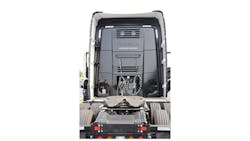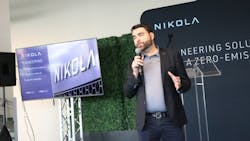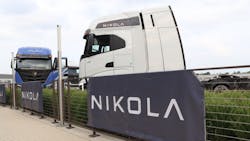PONTIAC, Michigan—Was this Nikola’s best week ever? After reporting on the company since October 2019, and getting to drive one of the truck maker’s fuel-cell electric vehicles (FCEVs), I’d have to say the argument holds water. H20, by the way, is the only byproduct the Phoenix-based OEM’s hydrogen trucks drip out after turning the sustainable fuel into electricity.
Now before we get into the good, let’s quickly recap the bad.
Since September 2020, the company endured short seller accusations of fraud, broken partnerships, recalls, and plenty of courtroom drama. On June 6, the stock (NKLA), once over $65, plummeted to 56 cents per share. Then Nikola abandoned the European market, gave up on a joint venture with Italian truck maker Iveco, and announced the layoff of nearly a quarter of its workforce.
The good news for Nikola is that all that bad karma seemingly evaporated this week.
Monday
On July 31, these FCEVs began to trickle off Nikola’s production line in Coolidge, Arizona. That officially marked Nikola, which also plans on offering energy and infrastructure solutions, as the first OEM in the U.S. to start series production on a hydrogen truck.
Back in 2020 when I spoke with Nikola founder Trevor Milton, who now awaits sentencing after being found guilty of one count of securities fraud and two counts of wire fraud, the plan was to start production on daycab and sleeper models in 2023. Development of the sleeper model has been put on hold for now, but its 2023 and Nikola has started production. The fact that the current Nikola team has been able to soldier on through the pandemic, controversies, and loss of investor confidence and hit that target is really quite an achievement.
Now, it’s important to note Milton had also said the trucks’ range would exceed 700 miles per fill-up and “the truck, the service, the warranty, the maintenance, all of it” would cost customers $1 per mile. (As charming as Milton was—and as inexperienced in trucking as I was at the time—that sounded a bit outlandish, to put it politely.)
In the real world, where Nikola’s executive team now resides, they say the Tre FCEV will on the conservative side get 500 miles per fuel-up, and take less than 20 minutes. This would put four to five megawatt hours of energy into the truck in the form of compressed hydrogen.
The Nikola Tre BEV, which went into production in March 2022, shares the same platform and many components, and has a 300-mile range. In drayage applications, it has been found to charge to 80% full capacity in 90 minutes with a 350-kilowatt charger.
This FCEV’s range and fill-up time makes it a viable option for drayage, less-than-truckload, regional hauls, and dual shift-duty cycles.
While Bosch provides the fuel cells and Hexagon the fuel tanks, Nikola has internally developed just about everything else. This includes low- and high-voltage architecture, the thermal system, user experience features, ECUs, and control software.
“Why is that relevant to our customers?” asked Christian Appel, Nikola's chief engineer. “Well, because we can have very short development and improvement and optimization cycles. We can update all of these ECUs over the air, and that really gives us the flexibility to react to any issues that arise, or any additional requests that our customers might have.”
The safety systems were also developed in-house. “That is critical, because there are some worries about hydrogen,” Appel said. “I can assure you that this truck is safe—very, very safe.”
Appel explained the crash-protection system goes “above and beyond regulations and industry standards.”
In total, Nikola has more than 200 sales orders for the Tre FCEV, from at least 18 customers. Biagi Bros Inc. will receive the first truck off the assembly line this fall if everything goes as planned. The California-based third-party logistics fleet, which has piloted the Tre FCEV since January 2022, ordered a total of 15 trucks, all expected by the end of the year.
Nikola also announced on July 31 that J.B. Hunt will purchase 10 Nikola Tre battery-electric vehicles (which began production in March 2022) and three FCEVs. J.B. Hunt (No. 4 on the FleetOwner 500: Top For-Hire Fleets of 2023) will also source its hydrogen and fueling infrastructure from Nikola’s Hyla brand.
Tuesday
The company revealed on Aug.1 that HYLA will receive an additional $16.3 million in grants to grow out its hydrogen infrastructure network. The awards come from EnergIIZE West Sacramento California Energy Commission, Mobile Source Air Pollution Reduction Review Committee, and both Sacramento Metropolitan and South Coast Air Quality Management Districts.
This is in addition to the $41.9 million awarded from a Trade Corridor Enhancement Program (TCEP) grant. The funds will support the construction of seven hydrogen stations in California. Nikola aims to have 60 hydrogen stations by 2026. Through a partnership with TravelCenters of America, Nikola will have the first public hydrogen fueling station available in Ontario, California, in the near future.
See also: Voltera, Nikola to fund up to 50 hydrogen refueling stations
“What we have to find are solutions for five trucks up to hundreds of trucks,” noted Jason Roycht, Nikola’s global head of FCEV market development. “And we've worked very hard with the industry and our own engineering to come up with fueling solutions that will match that, from mobile fueling solutions that can support five to 10 trucks to modular solutions we can install at a customer's facility or a public facility to support 20 to 50 trucks.”
Nikola has long planned to offer a bundle option that includes costs of trucks, fueling, and maintenance so that’s two out of three taken care of.
Wednesday
On Aug. 2, Nikola invited customers, government officials, and the media (including myself) to the M1 Concourse, an event track to show off the Tre BEV production model and the pilot (gamma) version of the Tre FCEV. Alta Equipment Group, a forklift (both lithium-ion and fuel cell) and construction equipment dealer out of nearby Livonia, was also on hand, as they will be providing Nikola customers with installation, leasing, refueling and charging, and long-term maintenance in 15 states for both Tre models.
While commercialized fuel-cell trucks are as new as a technology can be, Mike Bucci, VP of Alta eMobility, is confident the company is up to the challenge, as the 100 or so sales folks have plenty of subject-matter expertise to discuss the total cost of ownership benefits of fuel cells over traditional powertrains.
“The roadmap is the same whether you’re selling a forklift or a semi-truck,” Bucci offered. “You meet with customers and you assess their needs.”
That sweet, sweet government money makes Alta’s job much easier. Through the Inflation Reduction Act, customers could be eligible for a $40,000 clean commercial vehicle tax credit, and the California HVIP grants up to $288,000 per FCEV.
“When you spread out payments over five or six years and factor in your monthly cost, you’re pretty much at diesel cost parity in the first month with vouchers and HVIPs,” Bucci said. He explained this is due to diesel price fluctuation and maintenance costs.
When fleets start running 20 to 100 FCEVs, that will also drive down the fueling cost, he said.
The Nikola Tre FCEV test drive
Speaking of driving, you’re probably wondering what it’s like to drive a fuel-cell truck. First off, I don’t have a CDL, though the M1 is a closed track, so I didn’t need one. And the last time I drove a Class 8 was in 2019 (the Mack LR Electric refuse model). Surprisingly, the Tre FCEV wasn’t all that different from driving a regular car. You’re much higher up, of course, but unlike other heavy-duty trucks I’ve sat in, the Tre didn’t feel too big. The seat was comfortable, easily adjustable, as was the steering wheel.
As for noise, from the outside, I could hear the screech of parking brakes and a light whirr; inside it was so quiet I didn’t realize the fuel cells were on, until my co-pilot, Neil Koelle, Nikola’s vehicle engineering garage manager, told me we were ready to go (once I released the parking brake).
Aside from being lighter and running on hydrogen, the FCEV Fuel operates very much like any EV, with instant torque. The Tre FCEV specifically has 400 kW (536 horsepower) of continuous power, and 12,500 ft.-lb. of continuous wheel torque. The Tre BEV is more powerful, with 645 horsepower equivalent.
I wasn’t about to truly test the upper limits of the truck at the start, with several people and other trucks in the vicinity. It was easy to gently guide the truck to the track entrance, and when I wanted to accelerate, I did in short order.
The cab is more akin to a surround of technology than a conventional truck. To the right of the driver’s seat is a 17-inch infotainment screen. From here, one can access anything they need, from telematics to diagnostics info, if you’re a technician.
I could also keep track of how much energy was leaving or coming in to the right of the odometer. This would fluctuate based on if I was accelerating or if the regenerative brakes were working.
Koelle noted that the “shifter” jutting from the right side of the steering column is actually the regenerative braking controls. It has six settings, with “1” being least aggressive and “6” the most. With the battery topped off, there wasn’t any room for extra electrons from braking energy, so I kept it set to low.
Drivers, I’m sure, will figure out how to get the most efficient use of regenerative braking in a few days with the right training. Nikola will use the autonomous PlusDrive platform to provide an AI-assisted version of regen braking, possibly by the end of next year. That would require installing new hardware in the trucks, a Nikola spokesperson said.
After testing out the acceleration and braking, which lasted only briefly, we went around some cones in the center of the track. The electric steering made this incredibly simple, and because the Tre is a cabover style, maneuvering was already pretty easy. For drivers in urban routes with tight turns and lots of congestion, I could see this being very popular.
It was truIy was a great ride, but because of my lack of similar experiences, that shouldn’t mean much. Part of me liked it because it was like old-school Optimus Prime with bigger windshields, so consider the source. My best advice is if you get a chance to test one, do it.
Thursday
On Aug. 3, Nikola got the votes it needed to elect all nominees for director and approve each of the other proposals. This included the passage of Proposal 2, which authorized the number of shares of common stock.
Friday
Nikola’ concluded the week by announcing that Nikola President and CEO Michael Lohscheller is stepping down “due to a family health matter,” which is by no means good news.
Chairman Steve Girsky will take over as CEO. Steve Shindler, a director since 2020, assumes the role of chairman of Nikola's board.
Lohscheller was in the role for less than a year, though this week proved it was incredibly productive.
“I feel privileged and honored to have served as Nikola’s CEO and to have worked with so many inspiring colleagues who are relentlessly focused on advancing Nikola’s position as a leader in zero-emissions transportation. I am incredibly confident in Nikola’s future,” said Lohscheller.
Nikola also released its second-quarter 2023 earnings ahead of an investor call.
Along with what was already mentioned, Nikola pointed to the following highlights:
- Delivered 45 wholesale and 66 retail BEVs.
- Increased unrestricted cash position by $107.1 million while substantially reducing adjusted free cash flow to below our $150 million target for the quarter.
- Raised $233.2 million through capital raise and asset monetization, and improved visibility into future capital needs to fully fund the business model.
- Closed down battery production operations of Romeo Power Inc. and are establishing a battery pack line in Coolidge for our battery-electric trucks.
Despite Nikola's great week, success is not guaranteed. As recently as June, I was expecting to see the company announce it was shutting down, as not much would surprise me this summer. I can say that I feel better about their visibility now than anytime before.
And a big reason is because failure is such a great teacher, and Nikola has experienced plenty of failures on the winding path from hubris to humility. That is also the tone Roycht took when I asked how this week felt.
“Many of us want to make trucking better, want to make the earth better,” he said. “And a lot of us added making Nikola better to that list. It’s always been an emotional journey. We certainly made it harder on ourselves than it ought to have been."
Then he invoked the oft-used survivor’s mantra: “What doesn’t kill you makes you stronger.”
“We’re 100 times stronger than we would have been if this didn’t happen,” he concluded.







